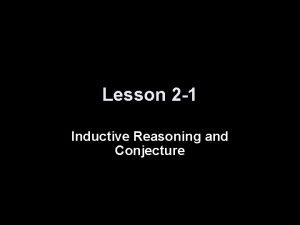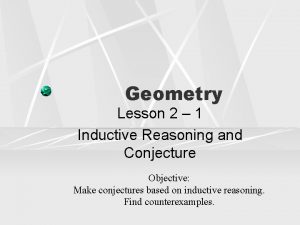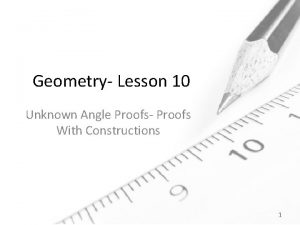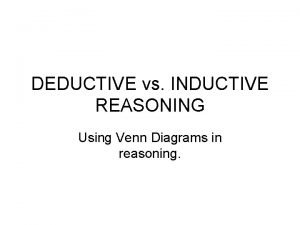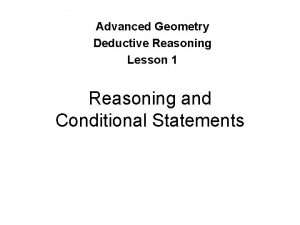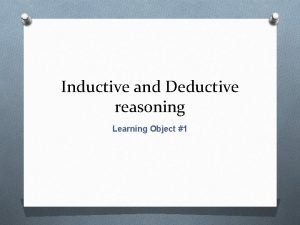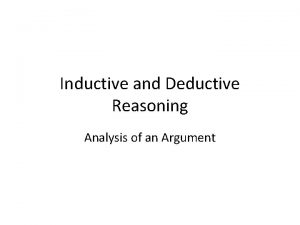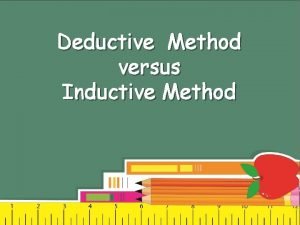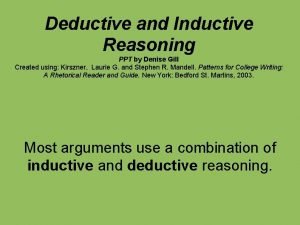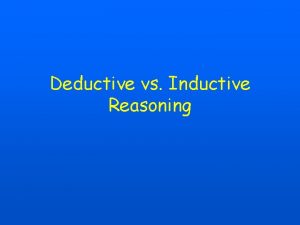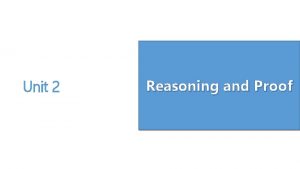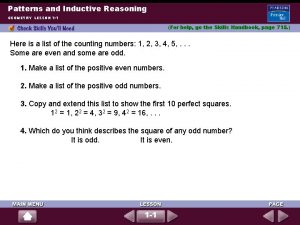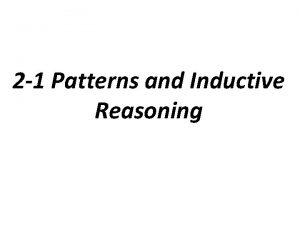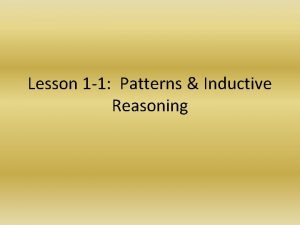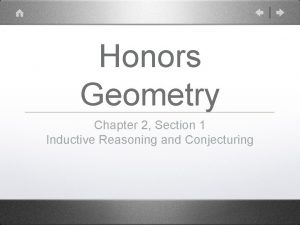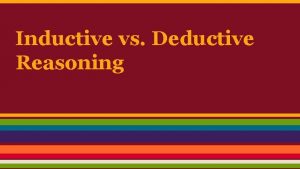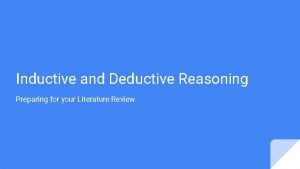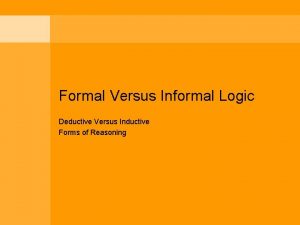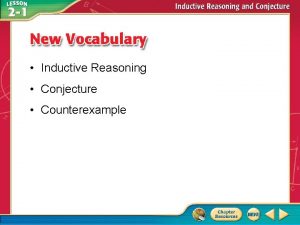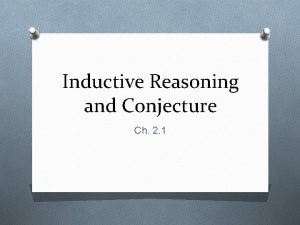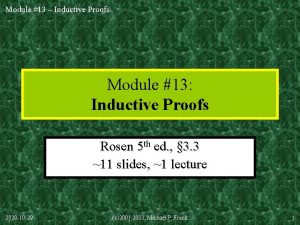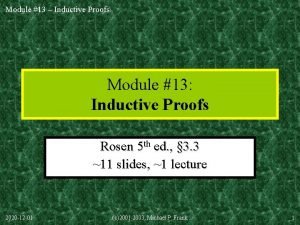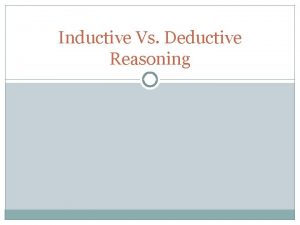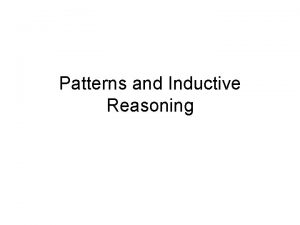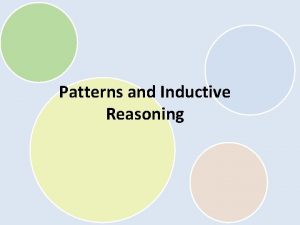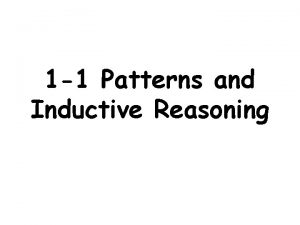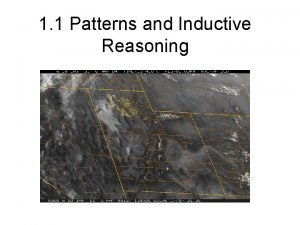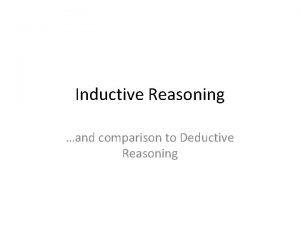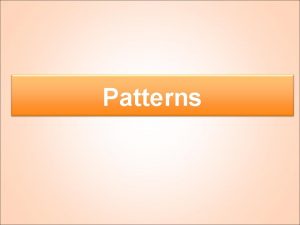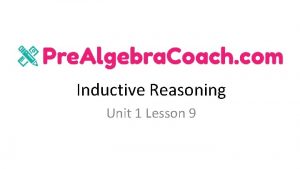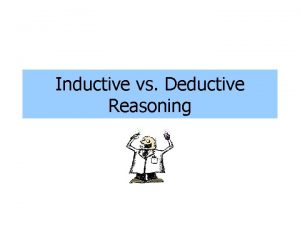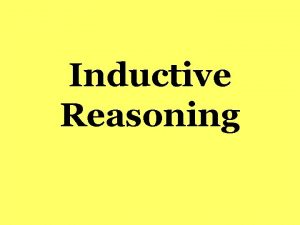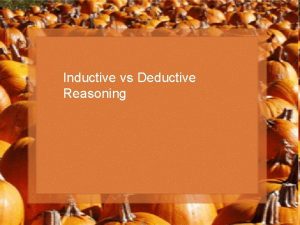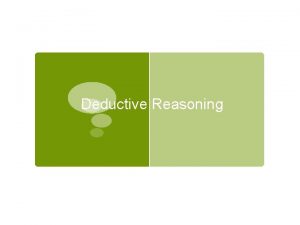Inductive Reasoning and Conjecture Proofs Definition Conjecture Educated





























- Slides: 29

Inductive Reasoning and Conjecture “Proofs”

Definition • Conjecture Educated Guess!!! Inductive Reasoning Steps you take to make your guess

Examples: • Brenda has just gotten a job as the plumber’s assistant. Her first task is to open all the water valves to release the pressure on the lines. The first four valves she discovered opened when turning counterclockwise… • What is her conjecture? All valves will be open by turning them counterclockwise

Examples: • Eric was driving his friend to school when his car suddenly stopped two blocks away from school… • What is his conjecture? The car run out of gas The battery cable lost its contact

Example: • For points A, B and C, AB = 10, BC = 8 and AC = 5… Summarize: Given : Points A, B and C AB = 10, BC= 8, AC = 5 What is our conjecture? Points A , B and C are noncollinear (not on the same line)

Examples • Given ∠ 1 and ∠ 2 are supplementary ∠ 1 and ∠ 3 are supplementary What is our conjecture? ∠ 2=∠ 3

Counterexamples: • Sometimes after we make a conjecture, we realize that the conjecture is FALSE. Its takes only one false example to show that a conjecture is NOT TRUE. The false example is called: Counterexample.

Counterexample: • Points P, Q and W are collinear. Joe made a conjecture that Q is between P and W. Determine if this conjecture is true or false? • Given: Points P, Q and W are collinear Joe’s Conjecture: Q is between P and R Solution: False, P W Q

Counterexample: • Determine of the conjecture is true of false? Given : FG = GH Conjecture: G is a midpoint of FH Is this statement TRUE or FALSE? Remember one example needed to show FALSE Solution: False, H F G G is NOT a midpoint, G is a vertex

More Examples: • Determine if this conjecture is TRUE or FALSE based on the given information. Given : Collinear Points D, E and F Conjecture: DE + EF = DF Solution: FALSE, E F D

More Examples: • Determine if this conjecture is TRUE or FALSE based on the given information. Given : ∠ A and ∠ B are supplementary Conjecture: ∠ A and ∠ B are adjacent Conclusion: FALSE, ∠ A= 30 ∠ B= 150

Conditional Statements “IF-THEN” 12

If- Then Statements • If- Then Statements are commonly used in everyday life. Advertisement might say: “If you buy our product, then you will be happy". Notice that “If-Then” statements have two parts, a hypothesis(the part following “if”) and a conclusion(the part following “Then”)

What is Conditional Statement? • Conditional Statements = “If-Then” statements. • The IF-statement is the hypothesis and the THEN-statement is the conclusion. 14

Ex: Underline the hypothesis & circle the conclusion. • If you are a brunette, then you have brown hair. hypothesis conclusion

Ex: Rewrite the statement in “if-then” form 1. Vertical angles are congruent. If there are 2 vertical angles, then they are congruent. If 2 angles are vertical, then they are congruent.

Identify Hypothesis and Conclusion. If a polygon has 6 sides, then it is a hexagon. Hypothesis: A polygon has 6 sides Conclusion: It is a hexagon. 17

• Identify Hypothesis and Conclusion John will advance to the next level of play if he completes the maze in his computer game. Hypothesis: John completes the maze in his computer game Conclusion: He will advance to the next level of play 18

Write a Statement in If-Then Form A five-sided polygon is a pentagon Hypothesis: A polygon has five sides Conclusion: It is a pentagon If a polygon has five sides, then it is a pentagon 19

True or False? • “IF-THEN“ statements can be TRUE or FALSE. Its false when the hypothesis is true and the conclusion is false. EX: If you live in Idaho, you live in Boise False EX: Not all people who live in Idaho live in Boise

True or False? EX: If two angles are congruent, then they are vertical Make sure to show an example to prove false. EX: False, We can have two congruent angles that are not vertical 21 21

Ex: Find a counterexample to prove the statement is false. • If x 2=81, then x must equal 9. counterexample: x could be -9 because (-9)2=81, but x≠ 9.

Abbreviation • Form of statement: If hypothesis then conclusion We say : p q, where p is called hypothesis, q is called conclusion 23

Some More… • New Statements can be formed from the original statement. • Original “If-Then”: p q • Converse: q p • Inverse: ~ p ~ q , where “~” means NOT • Countrapositive: ~ q ~ p

Examples: • Rewrite the following statements in “If-Then” form. Than write a converse, inverse and contrapositive. Ex: “All elephants are mammals” If-Then form: If an animal is an elephant, then it is a mammal Converse: If an animal is a mammal, then it is an elephant Inverse: If an animal is not an elephant, then it is not a mammal Countrapositive: If an animal is not a mammal, then it is not an elephant

The original conditional statement & its contrapositive will always have the same meaning. The converse & inverse of a conditional statement will always have the same meaning.

Practice


 Lesson 2-1 inductive reasoning
Lesson 2-1 inductive reasoning Inductive reasoning geometry examples
Inductive reasoning geometry examples What is deductive reasoning
What is deductive reasoning Deductive reasoning definition
Deductive reasoning definition Inductive reasoning moves from
Inductive reasoning moves from Deductive and inductive reasoning
Deductive and inductive reasoning Inductive reasoning vs deductive reasoning geometry
Inductive reasoning vs deductive reasoning geometry Inductive vs deductive
Inductive vs deductive Inductive reasoning is reasoning based on patterns
Inductive reasoning is reasoning based on patterns Lesson 10 unknown angle proofs-proofs with constructions
Lesson 10 unknown angle proofs-proofs with constructions Lesson 9 unknown angle proofs
Lesson 9 unknown angle proofs Deductive reasoning diagram
Deductive reasoning diagram Make a conjecture based on the given information
Make a conjecture based on the given information Example of a deductive argument
Example of a deductive argument What is inductive approach
What is inductive approach What are inductive arguments
What are inductive arguments Inductive vs deductive
Inductive vs deductive Is the declaration of independence inductive or deductive
Is the declaration of independence inductive or deductive Venn diagram inductive deductive reasoning
Venn diagram inductive deductive reasoning Chapter 2 reasoning and proof answer key
Chapter 2 reasoning and proof answer key Lesson 2-1 patterns and inductive reasoning answers
Lesson 2-1 patterns and inductive reasoning answers Patterns and inductive reasoning 2-1
Patterns and inductive reasoning 2-1 Practice 1-1 patterns and inductive reasoning
Practice 1-1 patterns and inductive reasoning 2-1 patterns and inductive reasoning worksheet
2-1 patterns and inductive reasoning worksheet Inductive and deductive reasoning
Inductive and deductive reasoning Inductive reasoning piaget
Inductive reasoning piaget Type of argument
Type of argument Deductive reasoning involves
Deductive reasoning involves Inductive literature review
Inductive literature review Informal deduction
Informal deduction
